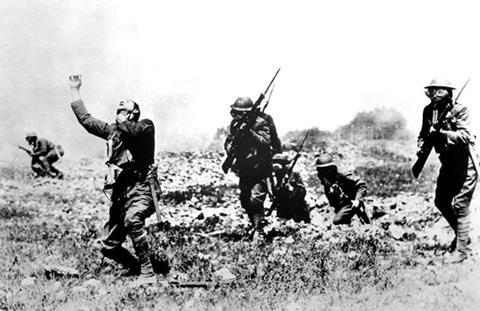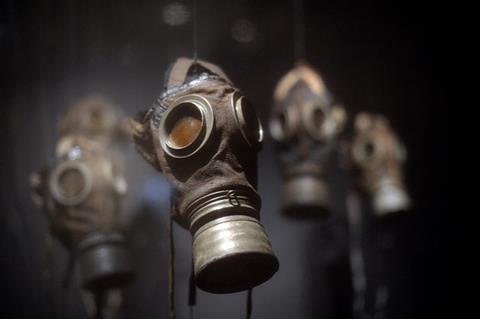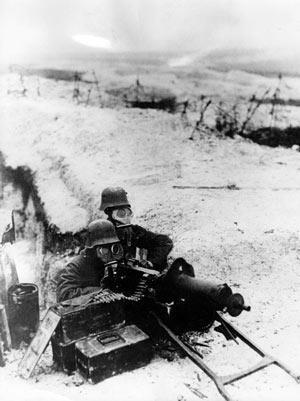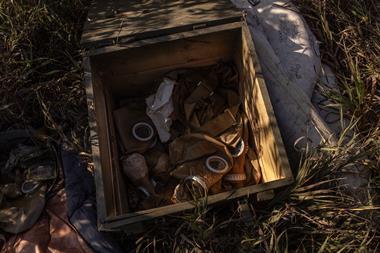The first world war not only exploited known chemistry but also led to significant advances. Michael Freemantle explains

The first world war, fought from late July 1914 to November 1918, pitted the industrial might and armies of the Central Powers, notably Germany, against the industrial might and armies of Britain, France and other Allied Powers. It was the first industrial world war and has been called the Chemists’ War. The conflict led to carnage on an unimaginable scale. Some 10 million members of the armed forces of the belligerent nations and a further five or six million civilians died as a result of the war. Furthermore, the intense and prolonged shelling on both sides of the western front destroyed farms, factories, villages, towns, roads and railways.
It is sobering for chemists to think that this industrial-scale slaughter and devastation would not have been possible without the industrial-scale production of a vast variety of chemicals. For example, during the four-year war of attrition along the western front, the opposing armies spent much of their time firing shells filled with lethal chemicals at one another. The compounds included TNT (trinitrotoluene) and other high explosives, chemical warfare agents like mustard gas, and incendiary materials such as phosphorus. And to propel these shells at high velocity through the air, the armies relied on other chemicals: propellants. The British used cordite, essentially a mixture of guncotton or collodion (both of which are forms of nitrocellulose) and nitroglycerine in petroleum jelly, for this purpose. The propellants were ignited by the flash generated by the explosion of a primary explosive such as mercury fulminate, Hg(CNO)2.
Perhaps surprisingly, almost all of the chemistry that underpinned and prolonged the first world war did not evolve as a result of the war. It evolved well before the war. It was discovered and developed largely by enthusiastic civilian chemists out of sheer curiosity and in all innocence with little or no concern for potential military applications. Only later did academic, government and industrial chemists in the belligerent countries mobilise this previously discovered chemistry and bring it into play for military purposes. They examined well-known chemicals, selected those most suitable for military use, improved the processes for their production, suggested alternative materials and processes when their respective countries experienced shortages, and finally developed analytical techniques to establish the composition and purity of these chemicals of war and determine the identity of unfamiliar chemicals used by the enemy.
A weapon of mass destruction
100 years ago this September, the British Army launched a weapon of mass destruction for the first time in its history. That weapon was chlorine gas. To keep the weapon secret, the gas was referred to as ‘the accessory.’ Between 5.40 and 6.30 on the morning of 25 September 1915, the British artillery released 140 tons of ‘the accessory’ from over 5000 pressurised metal cylinders against the Germans at the Battle of Loos in northern France.

The British troops experienced a number of problems as they released the chlorine. Some of the troops did not have correctly-fitting spanners to open the cylinder valves. Some of the lead pipes used to direct the gas from the cylinders towards the enemy leaked, allowing gas to escape back into the British trenches. Some of the cylinder valves froze as the gas was released and the troops were unable to close them. In addition, the wind was not always strong enough to carry the gas over the German trenches and at times blew back over the British trenches. Finally, German shells exploded in the British trenches bursting full chlorine cylinders releasing more gas into their trenches.
The introduction of chlorine as a chemical warfare agent on the western front in 1915 was a major new development in warfare. Earlier that year, the Germans had used the gas in a number of attacks, using it for the first time on 22 April 1915 in the Second Battle of Ypres. German gas troops, supervised by chemist Fritz Haber, unleashed 168 tons of chlorine from cylinders against the Allies defending a position at Langemarck, a village some four miles from Ypres, a town in Belgium. The Germans followed up the gas assault with an intense artillery bombardment of the Allied trenches and then an infantry attack that created a four-mile breach in the Allied lines. Thousands of Allied troops were killed or wounded in the attack.

Within days of the first German chlorine attack in April 1915, the Allies began to develop face masks to counteract the gas. The British Smoke Hood, introduced on the western front in May 1915, consisted of a flannel bag with a rectangular eyepiece. The flannel was soaked in an alkaline solution to neutralise the chlorine, which forms an acidic solution when it dissolves in water.
In December 1915, the Germans began mixing chlorine with phosgene, COCl2, another lethal gas, and discharging the mixture from cylinders in cloud gas operations against the Allies. Smoke hoods offered little protection against phosgene and so, in February 1916, the British began to issue box respirators to its troops. The respirator, designed by British chemist Edward Harrison, consisted of a facemask connected to a canister by a flexible rubber breathing tube. The canister contained a mixture of chemicals that neutralised chlorine, destroyed phosgene and other toxic gases, but allowed air to pass through.
The chemical warfare arms race continued throughout the war. The French began firing artillery shells filled with phosgene at the start of the Battle of Verdun in February 1916. And then, in the summer of 1917, the Germans started to fire shells filled with that most notorious of all chemical warfare agents, mustard gas, (ClCH2CH2)2S, an oily liquid also known as sulfur mustard. It released a vapour with a smell similar to that of mustard oil. Gas masks offered minimal protection against the oil or the vapour. The oil penetrated clothing, including leather and rubber boots and garments, causing painful blisters and burns. The vapour, if inhaled, resulted in terrible internal injuries.
Overall, a total of 68 chemicals were used or developed for use as chemical warfare agents by the warring powers in the war. Every single one of these agents was discovered well before the war. Chlorine, for example, was first prepared by German-born Swedish chemist Carl Scheele in 1774. He made the green gas by adding hydrochloric acid, then known as muriatic acid, to manganese dioxide. However, it was not until 1810 that English chemist Humphry Davy discovered that the gas was an element and named it chlorine. He derived the name from the Greek word chloros which means pale green.
The following year Davy’s younger brother John, also a chemist, discovered phosgene. He produced the gas by mixing equal volumes of gaseous chlorine and carbon monoxide and exposing the mixture to sunlight. The gas, he observed, was ‘more intolerable and suffocating than chlorine itself’. He named it after the Greek term for ‘formed by light.’
And it was one of the most famous chemists in the history of British chemistry, William Perkin, who, along with fellow organic chemist Baldwin Duppa, described the preparation of ethyl bromoacetate and ethyl iodoacetate in papers published in 1858 and 1859 respectively. The French used ethyl bromoacetate as a tear gas in hand grenades as soon as the conflict began. The British used ethyl iodoacetate as a tear gas at the Battle of Loos. It was dubbed ‘SK’ after South Kensington, the location of Imperial College, London, where tests on the use of the compound as a chemical warfare agent were carried out.
Explosives
Most of the chemical compounds used as high explosives and propellants in the war and the processes used for their manufacture were well known by the start of the war. Many of the processes had been developed for civilian applications and it was only after the war began that they were adapted for military use.

Haber’s famous synthesis of ammonia from atmospheric nitrogen and hydrogen extracted from water is a classic example. The process was patented in 1909 and developed on an industrial scale by a team led by Carl Bosch, another German chemist. It was first used in 1913 for the manufacture of nitrogenous fertilisers. Only after the start of the war did the Germans exploit the process for the manufacture of explosives. The ammonia was converted into the nitric acid required to make explosives such as TNT, nitrocellulose and nitroglycerine.
When both Germany and Britain began to experience shortages of TNT during the war, they began to mix it with ammonium nitrate. The mixture, which the British called ‘amatol,’ was a wartime invention, but its two explosive components were discovered long before the war. TNT was first synthesised by German chemist Julius Wilbrand in 1863 and initially used as a yellow dye. Germany began manufacturing the material in 1891 and three years later its army adopted it as a high-explosive filling for artillery shells. The history of ammonium nitrate dates back to 1654, the year German–Dutch chemist Johann Glauber first prepared the salt.
Insufficient supplies of acetone when the war broke out proved another major challenge to the British. Acetone has a long history and by the early 20th century it had become well established as a versatile solvent. The British desperately needed large quantities of the solvent for the production of cordite in the ever increasing amounts required to meet the demands of its army and navy. The solvent was also employed to make the fire-resistant cellulose acetate dope used to stiffen and waterproof the canvas wings of military aircraft, and to make 2,4,6-trinitrophenylmethylnitramine, a high explosive commonly known as ‘tetryl.’
If it had not been for Chaim Weizmann’s discovery in 1912 that acetone could be produced by the fermentation of grain, Britain would have found it difficult to sustain its war effort for four years. Weizmann developed the fermentation process on an industrial scale for the British war effort and later became known as the father of industrial fermentation. He was also a passionate supporter of the Zionist movement which aimed to establish a homeland in Palestine for the Jews. In 1949, he became the first president of the State of Israel.
Protective and caring roles
The first world war relied extensively on the use of well-known chemicals not only for killing and destruction but also for the protection of troops, for halting the spread of infections, and for the treatment and care of the sick and wounded.
Disinfectants such as bleaching powder, for example, were widely used to prevent the spread of infectious microorganisms in the trenches. Bleaching powder is calcium hypochlorite, Ca(OCl)2, also known as chloride of lime. Antiseptics like carbolic acid (phenol) and tincture of iodine (a mixture of iodine and potassium iodide in ethanol) were used for treating wounds. British Army medical officers also employed innovative antiseptics such as Eusol and Dakin’s solutions in casualty clearing stations and military hospitals.
Anaesthetics were widely used in military hospitals for carrying out amputations
Eusol, an acronym for Edinburgh University solution of lime, was an antiseptic solution prepared by dissolving equal weights of chloride of lime and boric acid, H3BO3, in water. Dakin’s solution was a non-irritant antiseptic solution used to treat infected wounds. The solution, named after the English chemist Henry Dakin who first prepared it, was made by dissolving sodium carbonate and bleaching powder in water and then filtering the solution to remove the calcium carbonate that precipitated. Boric acid was finally added to the solution. The solution did not store well and so had to be freshly prepared before use.
Anaesthetics such as chloroform, diethyl ether, and ethyl chloride were widely used, when available, in military hospitals for carrying out amputations. Although the use of these anaesthetics was well established before the war, army surgeons began to develop new procedures for employing them as the war progressed, for example, by mixing chloroform and ether together or by administering ethyl chloride and ether in sequence.
The use of radiography to identify bullets and shards of shells lodged inside the bodies of wounded soldiers advanced rapidly during the war. Yet it was only in 1895 that German physicist Wilhelm Röntgen discovered x-rays. At the start of the war, a radiograph required hours of exposure to x-rays but by the end of the war, x-ray apparatus had improved to such an extent that exposures were reduced to fractions of a second.
Unforeseen benefits
The war gave birth to a number of significant developments in chemistry that were completely unforeseen, even at the end of the war. Two of the most notable have their origins in the use of chemical weapons during the war, the first being the discovery of antioxidants by two organic chemists, Charles Moureu and Charles Dufraisse, while working on the French chemical warfare programme.
In January 1916, the French Army introduced the unsaturated aldehyde acrolein, CH2=CHCHO, as a filling for gas grenades and artillery gas shells. The chemical, a powerful tear gas and lung irritant, was not a great success as a chemical warfare agent because of its lack of chemical stability. The two French chemists observed that when acrolein was exposed to air, it spontaneously turned into a waxy resin. When they investigated the process, they discovered that acrolein and the oxygen in air combined in a process now known as autoxidaton to produce peroxides that catalysed the deterioration of the acrolein. The peroxides, they said, were ‘pro-oxygenic.’ They subsequently showed that acrolein decomposition could be inhibited by ‘anti-oxygenic’ compounds, most notably phenolic compounds.
Today, ‘anti-oxygenic’ compounds are known as antioxidants. They occur widely in nature. Vitamin C, for example, is an antioxidant that helps to maintain healthy skin and heal cuts and abrasions. Antioxidants are added to fat-containing foods to stop them going rancid and to rubber to slow ageing.
Moureu also made a major contribution to the second notable discovery, although the discovery was only to bear fruit several decades later. Part of Moureu’s chemical warfare work in France focused on mustard gas. The compound was first reported by Belgian-born French chemist César-Mansuète Despretz in 1822. English chemist Frederick Guthrie subsequently improved the synthesis and reported his work in 1860 – he also noted that the chemical caused blisters on the skin. After the Germans introduced mustard gas on the battlefield in the summer of 1917, Moureu, British chemists Charles Gibson and William Pope, and US chemist James Conant all set to work to produce the toxic agent for the Allies using variations of the Guthrie synthesis.
Soon after the end of the first world war, researchers reported that the blood counts of soldiers who had been poisoned by mustard gas in the war were low. Before long, scientists realised that the poison and related compounds might be used as anti-cancer drugs to suppress the abnormally rapid division and proliferation of blood and bone marrow cells that result in leukaemia and malignant tumours of the lymph nodes known as lymphomas.
In 1935, several groups of scientists reported the syntheses of nitrogen mustards, the most important of which was mustine, (ClCH2CH2)2NCH3. During the second world war, US pharmacologists Alfred Gilman and Louis Goodman began to investigate in secrecy the clinical use of mustine to treat lymphomas. They reported the results of their trials in a landmark article published in 1946. The work sparked an explosion of interest and research in the use of cytotoxic chemicals to treat cancer.
The first world war demonstrated chemistry’s ability to act as a double-edged sword in a way that had never been seen before. The inventions and discoveries of chemists before the war helped prevent the spread of infection and led to better care of the sick and wounded during the war. But at the same time, they opened up a Pandora’s box of death and destruction.
Michael Freemantle is a science writer based in Basingstoke, UK, and the author of The chemists’ war: 1914–1918, published by the RSC in 2014 and was reviewed by Chemistry World in November 2014












No comments yet